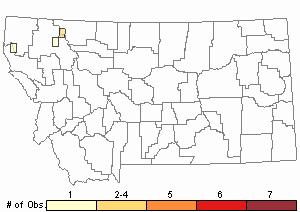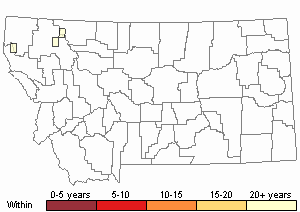View in other NatureServe Network Field Guides
NatureServe
Montana
Utah
Wyoming
Idaho
Wisconsin
British Columbia
South Carolina
Yukon
California
New York
Acute Blindia Moss - Blindia acuta
General Description
Plants: Acrocarpous (FNA 2007). Forming dark mats on acidic stone (FNA 2007), or growing in uncrowded tufts, typically slightly glossy, brown, yellow, or occasionally pale green, becoming dark brown to blackish below, to 7 cm in height (Crum and Anderson et al. 1981). Stem sometimes forked, the deciduous leaves sometimes causing it to be bare below (Lawton 1981).
Leaves: Rigid (Lawton 1981), upright or spreading some, sometimes the tips pointing in the same direction, similar in the dry state, lance-shaped and tapering to a long, slim point; costa occupying all or almost all of the fleshy subula, extending beyond the apex, often brown proximally (Crum and Anderson et al. 1981); margins smooth below, finely toothed above; apex broadly angled (FNA 2007).
Leaf Cells: Laminal cells smooth, square or elongated; alar cells swollen (FNA 2007) and brownish (Crum and Anderson et al. 1981).
Diagnostic Characteristics
B. acuta lives in acidic habitats whereas Seligeria species are calcareous and not as large (FNA 2007).
Range Comments
North American Range
AK, YT and NT, s to CA and CO, also present in NU, ON, QC, NB, NS, MI, MN, scattered states in the northeastern United States, TN and NC (FNA 2007). Known in Montana from Flathead, Glacier, and Sanders Counties (Elliott 2016).
Observations in Montana Natural Heritage Program Database
Number of Observations: 6
(Click on the following maps and charts to see full sized version)
Map Help and Descriptions
Relative Density

Recency


 (Observations spanning multiple months or years are excluded from time charts)
(Observations spanning multiple months or years are excluded from time charts)
Habitat
Moist, often dripping rock faces in alpine and montane habitats (Elliott 2016).
Reproductive Characteristics
Dioicous. Perigonial bracts orange proximally (Lawton 1981). Perichaetial leaves hugging the stem; suddenly narrowing to the subula (Crum and Anderson et al. 1981). Seta 3-13 mm in length. Capsule egg-shaped to slim and pear-shaped, smooth; peristome teeth 16, smooth, lance-shaped (FNA 2007), deep russet (Crum and Anderson et al 1981).
Stewardship Responsibility
References
- Literature Cited AboveLegend:
 View Online Publication
View Online Publication Crum, H.A. and L.E. Anderson. 1981. Mosses of Eastern North America. 2 volumes. Columbia University Press, New York. 1328 pp.
Crum, H.A. and L.E. Anderson. 1981. Mosses of Eastern North America. 2 volumes. Columbia University Press, New York. 1328 pp. Elliott, J.C. and A.K. Pipp. 2018. A Checklist of Montana Mosses (1880-2018). Updated 3 January, 2020. Montana Natural Heritage Program, Helena, Montana. 73 pp.
Elliott, J.C. and A.K. Pipp. 2018. A Checklist of Montana Mosses (1880-2018). Updated 3 January, 2020. Montana Natural Heritage Program, Helena, Montana. 73 pp. Flora of North America Editorial Committee, eds. 2007. Flora of North America North of Mexico. Volume 27. Bryophytes: Mosses, Part 1. Oxford University Press, Inc., NY. xxi + 713 pp.
Flora of North America Editorial Committee, eds. 2007. Flora of North America North of Mexico. Volume 27. Bryophytes: Mosses, Part 1. Oxford University Press, Inc., NY. xxi + 713 pp. Lawton, E. 1971. Moss Flora of the Pacific Northwest. Hattori Botanical Laboratory. Japan: Yamabuki-cho, Shinjuku-ku, Tokyo. 362 pages plus appendices.
Lawton, E. 1971. Moss Flora of the Pacific Northwest. Hattori Botanical Laboratory. Japan: Yamabuki-cho, Shinjuku-ku, Tokyo. 362 pages plus appendices. Smith, A.J.E. 1980. The Moss Flora of Britain and Ireland. Cambridge University Press, Cambridge. 705 pp.
Smith, A.J.E. 1980. The Moss Flora of Britain and Ireland. Cambridge University Press, Cambridge. 705 pp.
- Additional ReferencesLegend:
 View Online Publication
View Online Publication
Do you know of a citation we're missing? Elliot, J. C. 1993. Second checklist of Montana mosses. Unpublished report. U.S. Forest Service, Region 1. Missoula, MT. 45 pp.
Elliot, J. C. 1993. Second checklist of Montana mosses. Unpublished report. U.S. Forest Service, Region 1. Missoula, MT. 45 pp. Lawton, E. 1971. Keys for the Identification of the Mosses on the Pacific Northwest. Reprinted from 'Moss Flora of the Pacific Northwest'. Published as Supplement No. 2 of the Journal of the Hattori Botanical Laboratory. Nichinan, Miyazaki, Japan. 66 pp.
Lawton, E. 1971. Keys for the Identification of the Mosses on the Pacific Northwest. Reprinted from 'Moss Flora of the Pacific Northwest'. Published as Supplement No. 2 of the Journal of the Hattori Botanical Laboratory. Nichinan, Miyazaki, Japan. 66 pp. Malcolm, B., N. Malcolm, J. Shevock, and D. Norris. 2009. California Mosses. Nelson, New Zealand: Micro-Optics Press. 430 pp.
Malcolm, B., N. Malcolm, J. Shevock, and D. Norris. 2009. California Mosses. Nelson, New Zealand: Micro-Optics Press. 430 pp.
- Web Search Engines for Articles on "Acute Blindia Moss"





